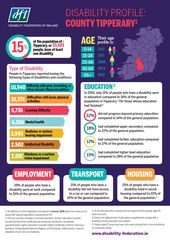Disability Profile - Tipperary
Issued on October 9 2018
Disability Profile: County Tipperary[1]
Population
15% of the population of Tipperary, or 23,593 people have at least one disability.
Age
Their age profile is:
0-14 2107
15 – 24 1757
25 – 44 3989
45 – 64 6973
65+ 8767
Type of Disability
People in Tipperary reported having the following types of disabilities and conditions:
A difficulty with pain, breathing, or any other chronic illness or condition | 10,940 |
Difficulties with basic physical activities | 10,374 |
Learning difficulty | 5,735 |
Mental health | 4,206 |
Deafness or serious hearing impairment | 3,945 |
Intellectual disability | 2,502 |
Blindness or a serious vision impairment | 2,091 |
Education[2]
In 2016, only 11% of people who have a disability were in education compared to 16% of the general population in Tipperary.[3] For those whose education had finished:[4]
- 32% did not progress beyond primary education compared to 14% of the general population.
- Only 18% had completed upper secondary compared to 22% of the general population.
- Only 12% had completed further education compared to 17% of the general population.
- Only 15% had completed higher level education compared to 28% of the general population.
Employment
- 19% of people who have a disability were at work compared to 51% of the general population.
Transport
- 21% of people who have a disability did not have access to a car or van compared to 10% of the general population.
Housing
- 15% of people who have a disability lived in social housing compared to 10% of the general population.[5]
[1] All statistics in this infographic are based on Census 2016 data from www.cso.ie.
[2] Primary and less includes no formal education, further education includes vocational/technical certificate and advanced certificate/ completed apprenticeship, higher education includes Higher Certificate, Ordinary/Honours Bachelor, Postgraduate Diploma/Degree, and Doctorate. Data based on special tabulation from CSO and Statbank.
[3] % of total education ceased and not ceased, and for people aged 15 years and over.
[4] Data is for highest level of education completed for people with a disability whose education has ceased.
[5] People aged 15 years and over, who were renting from a Local Authority or a Voluntary Body.

